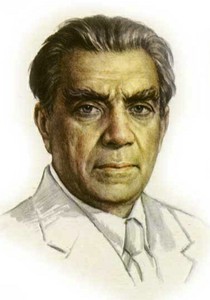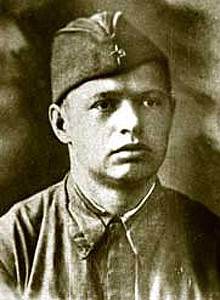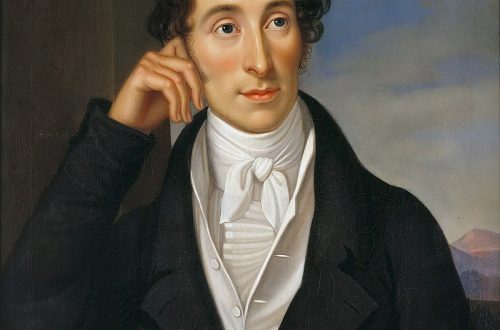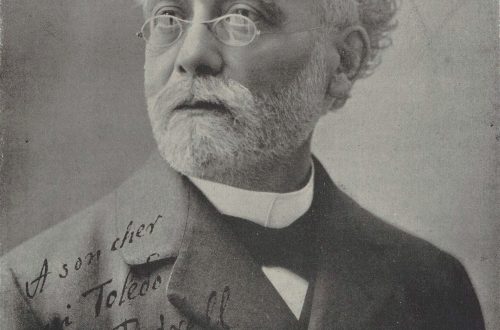
Reinhold Moritsevich Glière |
Contents
Reinhold Gliere
Gliere. Prelude (orchestra conducted by T. Beecham)
Gliere! Seven roses of my Persian, Seven odalisques of my gardens, Sorcery lord of Musikia, You turned into seven nightingales. Vyach. Ivanov

When the Great October Socialist Revolution took place, Gliere, already a well-known composer, teacher, and conductor at that time, immediately became actively involved in the work of building Soviet musical culture. A junior representative of the Russian school of composers, a student of S. Taneyev, A. Arensky, M. Ippolitov-Ivanov, with his versatile activities, he made a living connection between Soviet music and the richest traditions and artistic experience of the past. “I did not belong to any circle or school,” Glier wrote about himself, but his work involuntarily calls to mind the names of M. Glinka, A. Borodin, A. Glazunov because of the similarity in the perception of the world, which appears bright in Glier , harmonious, whole. “I consider it a crime to convey my gloomy moods in music,” the composer said.
Gliere’s creative heritage is extensive and varied: 5 operas, 6 ballets, 3 symphonies, 4 instrumental concertos, music for a brass band, for an orchestra of folk instruments, chamber ensembles, instrumental pieces, piano and vocal compositions for children, music for theater and cinema.
Starting to study music against the will of his parents, Reinhold by hard work proved the right to his favorite art and after several years of study at the Kiev Musical College in 1894 he entered the Moscow Conservatory in the class of violin, and then composition. “… No one has ever worked so hard in the classroom for me as Gliere,” Taneyev wrote to Arensky. And not just in the classroom. Gliere studied the works of Russian writers, books on philosophy, psychology, history, and was interested in scientific discoveries. Not satisfied with the course, he studied classical music on his own, attended musical evenings, where he met S. Rachmaninov, A. Goldenweiser and other figures of Russian music. “I was born in Kyiv, in Moscow I saw the spiritual light and the light of the heart…” wrote Gliere about this period of his life.
Such overstressed work did not leave time for entertainment, and Gliere did not strive for them. “I seemed like some kind of cracker … unable to gather somewhere in a restaurant, a pub, have a snack …” He was sorry to waste time on such a pastime, he believed that a person should strive for perfection, which is achieved by hard work, and therefore you need “will harden and turn into steel. However, Glier was not a “cracker”. He had a kind heart, a melodious, poetic soul.
Gliere graduated from the Conservatoire in 1900 with a Gold Medal, being by that time the author of several chamber compositions and the First Symphony. In subsequent years, he writes a lot and in different genres. The most significant result is the Third Symphony “Ilya Muromets” (1911), about which L. Stokowski wrote to the author: “I think that with this symphony you have created a monument to Slavic culture – music that expresses the strength of the Russian people.” Immediately after graduating from the conservatory, Gliere began teaching. Since 1900, he taught a class of harmony and an encyclopedia (that was the name of the extended course in the analysis of forms, which included polyphony and the history of music) at the music school of the Gnessin sisters; during the summer months of 1902 and 1903. prepared Seryozha Prokofiev for admission to the conservatory, studied with N. Myaskovsky.
In 1913, Gliere was invited as a professor of composition at the Kyiv Conservatory, and a year later became its director. Famous Ukrainian composers L. Revutsky, B. Lyatoshinsky were educated under his leadership. Glner managed to attract such musicians as F. Blumenfeld, G. Neuhaus, B. Yavorsky to work at the conservatory. In addition to studying with composers, he conducted a student orchestra, led opera, orchestral, chamber classes, participated in concerts of the RMS, organized tours of many outstanding musicians in Kyiv – S. Koussevitzky, J. Heifets, S. Rachmaninov, S. Prokofiev, A. Grechaninov . In 1920, Gliere moved to Moscow, where until 1941 he taught a composition class at the Moscow Conservatory. He trained many Soviet composers and musicologists, including A. N. Aleksandrov, B. Aleksandrov, A. Davidenko, L. Knipper, A. Khachaturian… no matter what you ask, he turns out to be a student of Glier – either direct, or grandchild.
in Moscow in the 20s. Glier’s multifaceted educational activities unfolded. He led the organization of public concerts, took patronage over the children’s colony, where he taught pupils to sing in chorus, staged performances with them, or simply told fairy tales, improvising on the piano. At the same time, for a number of years, Gliere directed student choral circles at the Communist University of the Working People of the East, which brought him many vivid impressions as a composer.
Gliere’s contribution to the formation of professional music in the Soviet republics—Ukraine, Azerbaijan, and Uzbekistan—is especially important. From childhood, he showed interest in folk music of various nationalities: “these images and intonations were for me the most natural way of artistic expression of my thoughts and feelings.” The earliest was his acquaintance with Ukrainian music, which he studied for many years. The result of this was the symphonic painting The Cossacks (1921), the symphonic poem Zapovit (1941), the ballet Taras Bulba (1952).
In 1923, Gliere received an invitation from the People’s Commissariat of Education of the AzSSR to come to Baku and write an opera on a national theme. The creative result of this trip was the opera “Shahsenem”, staged at the Azerbaijan Opera and Ballet Theater in 1927. The study of Uzbek folklore during the preparation of the decade of Uzbek art in Tashkent led to the creation of the overture “Ferghana Holiday” (1940) and in collaboration with T. Sadykov operas “Leyli and Majnun” (1940) and “Gyulsara” (1949). Working on these works, Gliere became more and more convinced of the need to preserve the originality of national traditions, to look for ways to merge them. This idea was embodied in the “Solemn Overture” (1937), built on Russian, Ukrainian, Azerbaijani, Uzbek melodies, in the overtures “On Slavic Folk Themes” and “Friendship of Peoples” (1941).
Significant are the merits of Gliere in the formation of the Soviet ballet. An outstanding event in Soviet art was the ballet “Red Poppy”. (“Red Flower”), staged at the Bolshoi Theater in 1927. It was the first Soviet ballet on a modern theme, telling about the friendship between the Soviet and Chinese peoples. Another significant work in this genre was the ballet “The Bronze Horseman” based on the poem by A. Pushkin, staged in 1949 in Leningrad. The “Hymn to the Great City”, which concludes this ballet, immediately became widely popular.
In the second half of the 30s. Gliere first turned to the genre of the concerto. In his concertos for harp (1938), for cello (1946), for horn (1951), the lyrical possibilities of the soloist are widely interpreted and at the same time the virtuosity and festive enthusiasm inherent in the genre are preserved. But the true masterpiece is the Concerto for voice (coloratura soprano) and orchestra (1943) – the composer’s most sincere and charming work. The element of concert performance in general was very natural for Gliere, who for many decades actively gave concerts as a conductor and pianist. Performances continued until the end of his life (the last took place 24 days before his death), while Glier preferred to travel to the most remote corners of the country, perceiving this as an important educational mission. “… The composer is obliged to study until the end of his days, improve his skills, develop and enrich his worldview, go forward and forward.” These words Glier wrote at the end of his career. They guided his life.
O. Averyanova
Compositions:
operas – opera-oratorio Earth and Sky (after J. Byron, 1900), Shahsenem (1923-25, staged 1927 in Russian, Baku; 2nd edition 1934, in Azerbaijani, Azerbaijan Opera Theater and ballet, Baku), Leyli and Majnun (based on the poem by A. Navoi, co-author T. Sadykov, 1940, Uzbek Opera and Ballet Theater, Tashkent), Gyulsara (co-author T. Sadykov, staged 1949, ibid), Rachel ( after H. Maupassant, final version 1947, artists of the Opera and Dramatic Theater named after K. Stanislavsky, Moscow); musical drama — Gulsara (text by K. Yashen and M. Mukhamedov, music composed by T. Jalilov, recorded by T. Sadykov, processed and orchestrated by G., post. 1936, Tashkent); ballets – Chrysis (1912, International Theatre, Moscow), Cleopatra (Egyptian Nights, after A. S. Pushkin, 1926, Musical Studio of the Art Theater, Moscow), Red Poppy (since 1957 – Red Flower, post. 1927, Bolshoi Theater , Moscow; 2nd ed., post. 1949, Leningrad Opera and Ballet Theatre), Comedians (Daughter of the People, based on the play “Fuente Ovehuna” by Lope de Vega, 1931, Bolshoi Theater, Moscow; 2nd ed. under the title Daughter of Castile, 1955, Stanislavsky and Nemirovich-Danchenko Musical Theater, Moscow), The Bronze Horseman (based on the poem by A. S. Pushkin, 1949, Leningrad Opera and Ballet Theatre; USSR State Pr., 1950), Taras Bulba (based on the novel by N.V. Gogol, op. 1951-52); cantata Glory to the Soviet Army (1953); for orchestra – 3 symphonies (1899-1900; 2nd – 1907; 3rd – Ilya Muromets, 1909-11); symphonic poems – Sirens (1908; Glinkinskaya pr., 1908), Zapovit (in memory of T. G. Shevchenko, 1939-41); overtures – Solemn overture (On the 20th anniversary of October, 1937), Fergana holiday (1940), Overture on Slavic folk themes (1941), Friendship of peoples (1941), Victory (1944-45); symp. a picture of the Cossacks (1921); concerts with orchestra – for harp (1938), for voice (1943; State Prospect of the USSR, 1946), for wlc. (1947), for horn (1951); for brass band – On the holiday of the Comintern (fantasy, 1924), March of the Red Army (1924), 25 years of the Red Army (overture, 1943); for orc. nar. tools — Fantasy Symphony (1943); chamber instrument orc. production – 3 sextets (1898, 1904, 1905 – Glinkinskaya pr., 1905); 4 quartets (1899, 1905, 1928, 1946 – No 4, USSR State Pr., 1948); for piano – 150 plays, incl. 12 children’s plays of medium difficulty (1907), 24 characteristic plays for youth (4 books, 1908), 8 easy plays (1909), etc.; for violin, incl. 12 duets for 2 skr. (1909); for cello – over 70 plays, incl. 12 leaves from an album (1910); romances and songs – OK. 150; music for drama performances and films.





